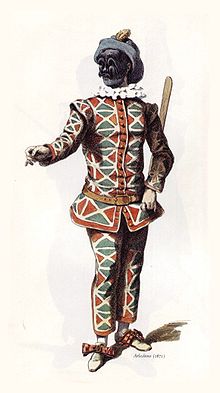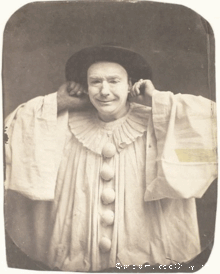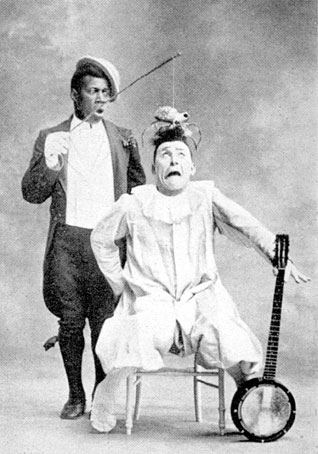The Pierrot drama of Les Enfants du Paradis comes from the commedia dell'arte of the Italian Renaissance and earlier medieval drama. In the early twentieth century , there was an influential group of classical scholars, mostly at Cambridge University, the “myth and ritual school,” Gilbert Murray, Jane Harrison, Lane Cooper, Francis Cornford and others. They traced the commedia back to Roman Comedy, Greek New and Old Comedy, and even further, to unwritten fertility dramas. While this line of scholarship has fallen out of favor, I still like to believe them. Se non é vero, é ben trovato. If you are interested in this genealogy here are more details.
The ritualists concluded, and I like to think, that the commedia dell’arte derived from ancient sources. Immediately, it derived from earlier forms of Italian comedy which in turn derived from the Roman comedy of Plautus and Terence. They in turn drew on Greek New Comedy. This was a comedy based on universal types. It sophisticated Greek Old Comedy—the comic playwright Aristophanes being virtually our only example. Old Comedy used, not types, but particular people from the streets of Athens, like Peisistratus or Socrates (who takes a quite irreverent drubbing from his comic contemporary).
Greek theater was a competitive event enmeshed within a complex religious festival. The drama played within a ritual that may have included the sacrifices and prayers and feasting of the Dionysiac rite. Indeed the endings of some Old Comedies go right into the ritual feast itself.
Old Comedy was thus religious and political, and it aimed originally at purifying the city of its faults, embodied in this or that person, by making fun of them and rejecting them. More secular, New Comedy like Menander’s turned the characters of Greek Old Comedy from actual persons into familiar types from everyday life. Less particular, more farcical and romantic, this kind of comedy fitted all times and places, expressing the philosophical, even psychological, interests of the later period. New Comedy thus pointed toward modern forms, like the commedia dell’arte or, indeed, Les enfants itself.
Both New and Old Comedy, however, according to the “ritualist” school, fitted their characters into types derived from even earlier forms. They may have stemmed from the komos, a kind of roving drinking party associated with the worship of Dionysus, god of laughter, drunkenness, and dark psychic forces—in general, the irrational. The komos involved ritual abuse—a “roast,” we would call it—like Old Comedy.
Further, for the ritualists and for me, the Old Comedy roast derived ultimately from prehistoric, unrecorded fertility dramas. These unwritten fertility dramas served a ritual, religious purpose. They sought to ensure a good harvest by re-enacting the triumph of spring over winter, plenty over famine, or the new year over the old. They took the form of a fight between a protagonist and an antagonist, throwing out the latter and thereby cleansing the community. The protagonist or eiron was just that, ironic, a man who seemed to be less strong, less clever, and, in general, less than he turned out to be in fact—Baptiste as the oaf son. His antagonist was an alazon, a boastful figure pretending to be more strong, clever, and powerful than he proved to be. He becomes the European auguste clown. These primordial clown types survive into our own time. Think of Laurel and Hardy.
In Enfants, they are Pierrot and Harlequin, Baptiste and Frédérick. The alazon would be associated with death (the “duels”) and the blackface that Frédérick wears in this movie when he plays Othello. (In French passion plays, the stock character Hellequin was a black-faced emissary of the devil.) The eiron (dead and reborn) shows in the whiteface of Pierrot-Baptiste, a whiteness associated with the dead (and the modern European “white” clown—Part II is called “L’homme blanc”). At first the alazon seems to triumph, but the eiron comes back to life and wins in the end, marrying a silent woman (like Garance) who stands for the community or plenty or the earth.
Those dramas evolved into the commedia and thence into Les Enfants du paradis. We, or I, at least, want Baptiste to triumph, banishing the seemingly bigger men, Edouard, Lacenaire, and Frédérick, securing the goddess for himself. And he does. She loves him, not them. But in Les Enfants the eiron does not get to marry Garance, silent in her departing carriage. Alas.


